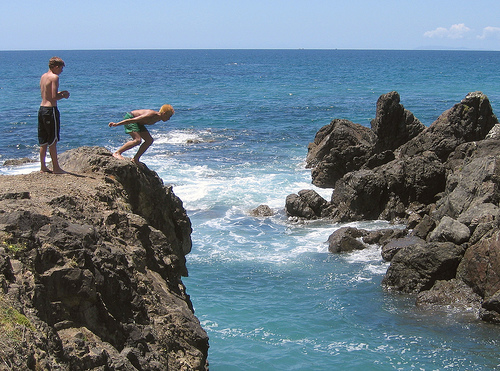Taking risks is part of life. It is most definitely part of growing up.
If we don’t take risks we never learn about our own capabilities or discover the joy of new experiences. Risk can be good, but they can also be unhealthy. Part of an adult’s role in nurturing teenagers is to encourage risks in safe environments and equip them to avoid taking risks in situations where they could endanger themselves or others.
In this post I want to look at the 3 main reasons teens engage in unhealthy risk taking. But first I want to make clear that not all risk is bad.
Healthy and Unhealthy Risks
Healthy risk-taking is a valuable experience. It is one that has the possibility of failure, but is also rewarding and relatively safe. Healthy risks that are good to encourage in teens include sporting activities, artistic & creative abilities (theatre, dance, music), volunteer activities, traveling, making new friends, or entering competitions (academic or athletic).
Unhealthy risk-taking behaviour includes driving too fast, texting or talking on the phone while driving, unprotected sex, smoking, excessive alcohol consumption, stealing, gang activity, or disordered eating.
It should be noted that although many adults interpret teenage risk taking as an act of rebellion, it rarely is. Rather risk taking in adolescence has much more to do with identity formation and self-definition than it does with making a statement about parents or society.
Brain Development
A lot of teen behaviour has been explained over recent years from what has been learned from adolescent brain research. Risk taking behaviour has been attributed to the asymmetrical development in different parts of the teenage brain.
The pre-frontal cortex is at the front of brain, just behind the forehead, and is the part of the brain that governs executive functions such as reasoning, critical thinking, and exercising self-control. Further towards the centre of the brain is the amygdala. This part of the brain controls our emotional more primal urges.
The pre-frontal cortex develops later than the amygdala. As teens seek out new sensations and new experiences, the under developed pre-frontal cortex means their brain has trouble controlling risk taking impulses and understanding the consequences of their actions. So teens will often respond on impulse rather than think practically and consider the ultimate consequences of their decision.
Peer Pressure
Elsewhere in this blog I have discussed the important role peers play in a teenager’s life. Peer pressure can have both positive and negative influence on teens.
One of the negative influences peer pressure has is encouraging unhealthy risk taking (it can also encourage positive risk taking).
The desire, or need, teens have to be accepted and be affirmed by their peers can be very strong. Sometimes referred to as the cool factor, or the intimidation factor, this need for acceptance can often result in teenagers choosing to take risks to either impress or be accepted by the group.
A study conducted at the National Institute of Health found that teens are more likely to engage in risky driving behaviours such as speeding, if they are accompanied by the same-gendered teens in the car.
There is no way to prevent teens being influenced by their peers. However we do know that not all teens are influenced by peers to the same degree. Teens with stable healthy relationships between them and their parents are less susceptible to the negative influences of peer pressure.
Identity Development
Part of the process of adolescence is developing new ways of thinking. As teenagers develop new cognitive skills they start to view the world differently, but not always accurately.
As teenagers leave behind childlike thinking they are able to think about themselves in new ways. They learn to see themselves as unique – in fact they can become quite obsessed with their own self and how unique they are.
One outcome of this self absorbed view of the world, or ego-centrism, is that teens believe that they are extra special, so special that although others may be vulnerable to harm they themselves are not. This sense of invincibility has been linked to many risk taking behaviours including unprotected sexual activity, illegal drag racing, and drug use.
Reducing Unhealthy Risk Taking
Adults can have influence upon the level of unhealthy risk taking in teenagers.
Healthy risk-taking can help prevent unhealthy risk-taking. Adults can help teens find opportunities to take healthy risks by encouraging them in constructive pursuits like sports or arts etc.
Model good risk taking patterns. If adults model unhealthy risk taking in their daily lives it is likely to influence how teens take risks. Teenagers are watching and imitating.
Regulate the context in which teenagers live so they avoid getting in situations where they are more prone to taking unhealthy risks.
Discuss risk taking with teenagers and help them learn how to evaluate risks and anticipate the consequences of their choices. Young teenagers in particular may not always be aware of the risks associated with certain behaviours.
Image by Sids1






